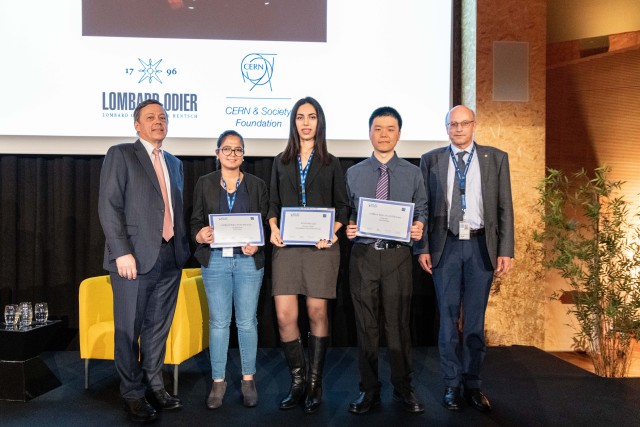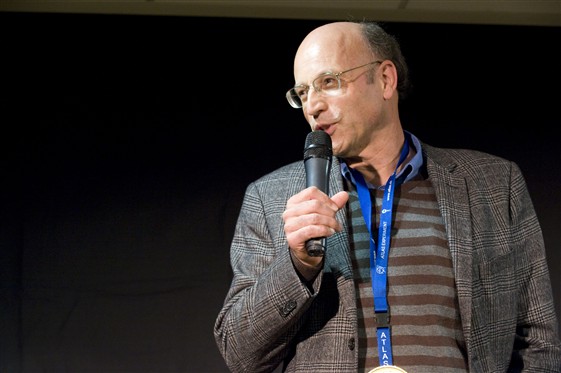Welcome to a brand edition of the Project Leadership Series! This series aims to explore the various activities under the wing of the CERN & Society Foundation, through the lens of the managers and mentors facilitating these projects. This time, we have with us Peter Jenni, mentor of the ATLAS Ph.D. Grant Scheme. A spokesperson for the ATLAS experiment from 1995-2009, Peter Jenni also served as the Deputy Chairman of the CERN & Society Foundation from 2014-2020. Let’s hear what he has to say!
Can you describe the ATLAS Ph.D. Grant Scheme in a few lines?

The ATLAS Ph.D. Grant makes it possible for some very talented and meritorious students to have the best conditions for a Ph.D. at ATLAS. Fabiola Gianotti and I started this scheme in 2013 from the award money of the Fundamental Physics Prize that we received. As students, both Fabiola and I were very excited to be able to spend some time at CERN working on the experiments, and now we wanted to open this possibility for others- pay it forward in a way.
We think this is a good opportunity for the students, where they stay at CERN for 18 months and at their home university for the rest, to attain their Ph.D. Of course, we have a moral obligation to see through the attainment of the Ph.D. and hence the home institute funds them at their home university as well.
What does the grant hope to achieve?
Not every person has a very easy life. Fabiola is from Italy and I am from Switzerland. But studying physics is not so easy everywhere else. So along with the very meritorious students, we also wanted to help those who do not find the path of studying physics so easily. Of course, this scheme isn’t reserved just for students coming from non-member states of CERN, but students from around the world are invited to apply! So far, we’ve had 18 students from around the world.
How does the grant work?
The procedure is quite formal, and it is hosted by the CERN HR department. The students submit an application with some mandatory attachments. The HR department makes the first screening for eligibility standards. Then, we have a selection board, which consists of a person from the HR department, a person from the ATLAS Collaboration – who has been collaborating from outside CERN, Fabiola (Gianotti), and myself. We study each file, make independent evaluations and give a ranking to the profiles, and finally meet to discuss these evaluations. The decisions are usually unanimous, the only problem is that we have too many candidates and not enough positions to award them!
In recent years, we also invite our biggest donors to observe the proceedings for fair evaluation processes. In addition, the selection is also presented to the Doctoral Student Committee at CERN, who will also apprise the selection for administrative tasks, leading to an additional independent check in the process.

Apart from being on the Selection Board, tell us about your role as the mentor
Whenever possible, every month or so, I love to chat with the students about physics and life and to answer any administrative questions they may have. I also provide the students with reference letters post their time at CERN as and when required. But the main hard work of the thesis work happens with the students and their supervisors, here and at their home institute. I just provide a guiding hand when required.
What do you look for in an ideal candidate?
Excellence is the first thing that we look for in a candidate. They should be very good at experimental physics and even in areas like computing. Each candidate provides a motivation letter and a research statement, which helps us know whether they have original ideas or not. Of course, this is not essential, but it helps us understand if the student has soaked in the knowledge that they have gained from their studies so far. The mandatory reference letters count too, but I believe the motivation letter is the one that truly allows us to understand the candidate well: their studies, their career paths, and the efforts they had to make to reach that level.
What do you think is the best feature of the programme?
For me, the best part is seeing the students grow! As they become more self-confident, they find their way in the Collaboration. In fact, many of the students end up doing a post-doc in wonderful universities around the world. Some go into the industry, into research, and more. One of the students even landed in finance! I love seeing the students take a chance and then doing wonderful things with their lives.
What impact has been created over the years?
All of our students have gone on to do worthy things in their lives. One of the first students we had, went on to work in Grenoble- a synchrotron radiation facility and now holds a wonderful position there! For example, one of our latest students, Chilufya Mwewa, had worked with the Cape Town University and then immediately achieved a post-doc position at the Brookhaven National Laboratory. She was a bit older than most students, her past not being an easy one, but she evolved from being a student to becoming my colleague! I am extremely proud of the fact that completing her Ph.D. through this scheme has opened so many opportunities for her.
Any advice for future applicants?
The first advice I would give is to be courageous and apply! Due to the limited number of seats, the success rate is quite low and hence, one has to be ready to take up the challenge of the application. But I believe that if you don’t apply, you will surely not get it! Each application needs a research plan and a motivation letter. I think that has a big impact on the application. We don’t expect the students to impress us with a long list of publications. What really impresses us is the feeling of the potential that the student may have. And I definitely resonate with the enthusiasm the student has in their application!
How is the scheme funded?
As I said, Fabiola Gianotti and I obtained the seed money for this scheme when we were awarded, together with the CMS project leaders and LHC machine lead, the Fundamental Physics Prize in 2013 for the “Leadership Role in the scientific endeavour that led to the discovery of the new Higgs-like particle by the ATLAS and CMS collaborations at CERN's Large Hadron Collider”. Later, the CERN & Society Foundation, which I served as Deputy Chairman of the Board for six years, took the project under its umbrella. This way, we were able to convince many more private donors to support the project and keep it alive for years to come.
What made you decide to donate this substantial prize money into setting up this scheme?
There are of course some prizes that are meant to be used for the research that the prize was meant for. In this case, there was no restriction. We could spend the money as we deemed fit. In the beginning, we joked about having some fun with this money, like let’s buy a Ferrari or something! But of course, both Fabiola and I immediately thought that we were able to receive the prize only because we were in the privileged position to be able to guide the experiment (with a lot of work nevertheless!). We wanted to put the sum towards educational and humanitarian projects. In the end, we felt that we were already paid for the job that we were hired to do and didn’t need more material feedback for that.